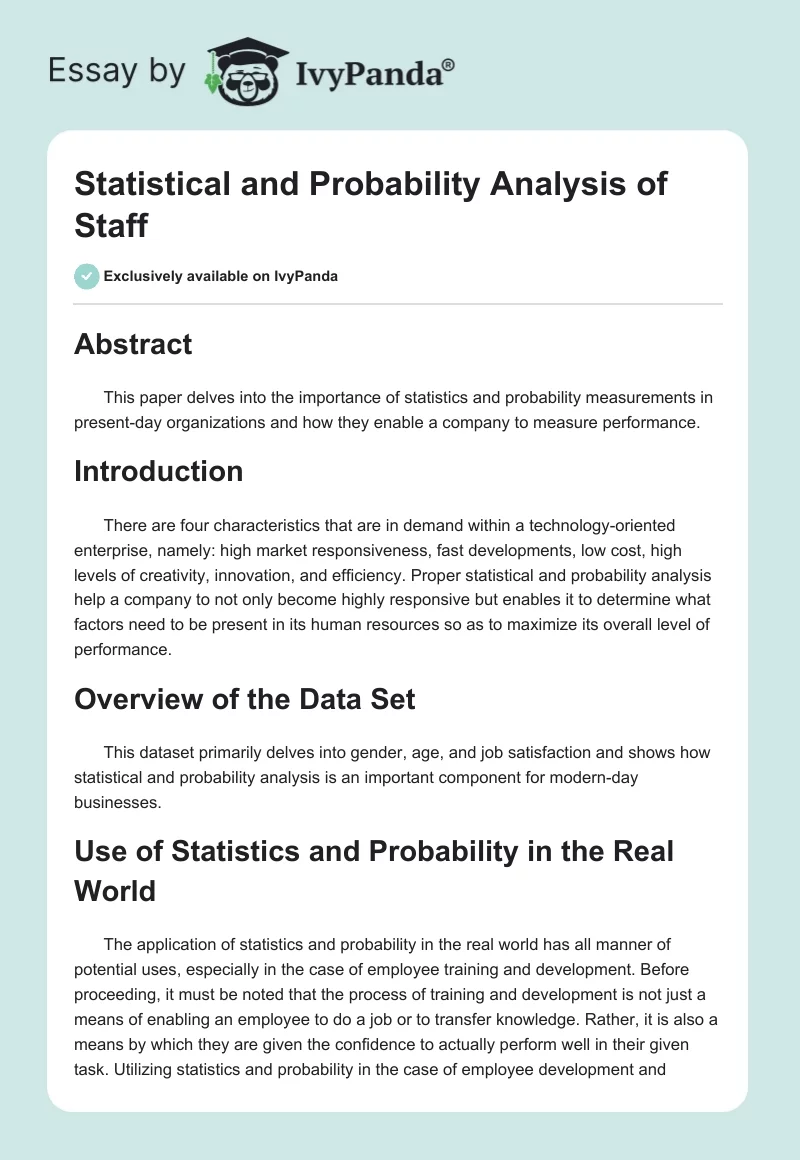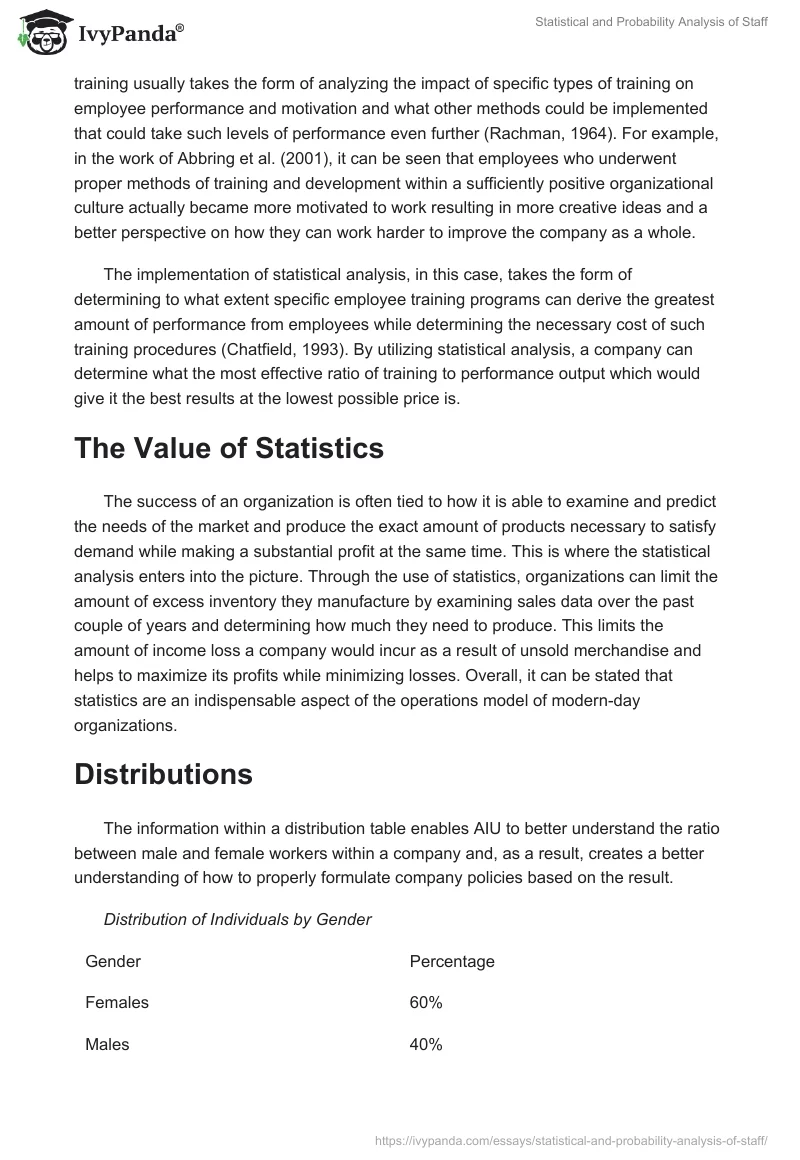Abstract
This paper delves into the importance of statistics and probability measurements in present-day organizations and how they enable a company to measure performance.
Introduction
There are four characteristics that are in demand within a technology-oriented enterprise, namely: high market responsiveness, fast developments, low cost, high levels of creativity, innovation, and efficiency. Proper statistical and probability analysis help a company to not only become highly responsive but enables it to determine what factors need to be present in its human resources so as to maximize its overall level of performance.
Overview of the Data Set
This dataset primarily delves into gender, age, and job satisfaction and shows how statistical and probability analysis is an important component for modern-day businesses.
Use of Statistics and Probability in the Real World
The application of statistics and probability in the real world has all manner of potential uses, especially in the case of employee training and development. Before proceeding, it must be noted that the process of training and development is not just a means of enabling an employee to do a job or to transfer knowledge. Rather, it is also a means by which they are given the confidence to actually perform well in their given task. Utilizing statistics and probability in the case of employee development and training usually takes the form of analyzing the impact of specific types of training on employee performance and motivation and what other methods could be implemented that could take such levels of performance even further (Rachman, 1964). For example, in the work of Abbring et al. (2001), it can be seen that employees who underwent proper methods of training and development within a sufficiently positive organizational culture actually became more motivated to work resulting in more creative ideas and a better perspective on how they can work harder to improve the company as a whole.
The implementation of statistical analysis, in this case, takes the form of determining to what extent specific employee training programs can derive the greatest amount of performance from employees while determining the necessary cost of such training procedures (Chatfield, 1993). By utilizing statistical analysis, a company can determine what the most effective ratio of training to performance output which would give it the best results at the lowest possible price is.
The Value of Statistics
The success of an organization is often tied to how it is able to examine and predict the needs of the market and produce the exact amount of products necessary to satisfy demand while making a substantial profit at the same time. This is where the statistical analysis enters into the picture. Through the use of statistics, organizations can limit the amount of excess inventory they manufacture by examining sales data over the past couple of years and determining how much they need to produce. This limits the amount of income loss a company would incur as a result of unsold merchandise and helps to maximize its profits while minimizing losses. Overall, it can be stated that statistics are an indispensable aspect of the operations model of modern-day organizations.
Distributions
The information within a distribution table enables AIU to better understand the ratio between male and female workers within a company and, as a result, creates a better understanding of how to properly formulate company policies based on the result.
Distribution of Individuals by Gender
Tenure with Company Distribution by Gender
Percentage of the Survey Participants in Each Department
Sample Mean for Extrinsic Value by Gender
Probabilities
In this section, what will be calculated are probabilities related to age, gender, and intrinsic level of satisfaction within the company. This type of examination enables AIU to better understand the distribution of employees within the company and how this relates to their overall level of job satisfaction.
Probabilities in the Business World
Employees from the present generation of employees (i.e., Gen Y) are initiative and performance-driven more so than they are loyal to a company. The fact remains that Gen Y employees are more likely to shift to new opportunities when they are presented and, as such, it is necessary to develop such opportunities within the company itself and arrange them so that advancement is dictated by an individual’s level of performance; this is where probability in business enters into the picture. Through the use of probability analysis, a company is able to determine the rate by which an employee should be able to complete their job and their overall level of performance. Such a system takes the form of the “metric” based method of employee evaluation which utilizes probability analysis to determine if an employee is working at the pace that they are supposed to (Maheu & McCurdy, 2009).
By creating a metric-based system where people are evaluated on their overall performance and promising quick advancement should such metrics be met, this would present itself as a viable opportunity for employees within a company ensuring that people within Gen Y would remain instead of going to the next best opportunity.
The reason why this is effective and widely implemented is that it conforms with the concepts of performance-based rewards and the search for opportunities which is ingrained in this particular generation. It must also be noted that performance-based initiatives would also help a company in the long run due to increased employee productivity (Demski et al., 2008).
Conclusion
Based on what has been presented so far, it can be seen that statistics and probability are important tools in the arsenal of any organization. Without sufficient application of such tools, it is likely that a business would flounder since it would be unable either to produce its products properly or to properly monitor the progress of its employees. As such, when implementing new business processes within a company, it is important to incorporate statistical and probability analysis into the operational framework in order to ensure that operations are conducted in a manner that is efficient and effective.
References
Abbring, J. H., Berg, G., & Ours, J. (2001). Business Cycles and Compositional Variation in U.S. Unemployment. Journal Of Business & Economic Statistics, 19(4), 436.
Chatfield, C. (1993). Calculating Interval Forecasts. Journal Of Business & Economic Statistics, 11(2), 121-135.
Demski, J. S., Fellingham, J. C., Lin, H. H., & Schroeder, D. A. (2008). Interaction between Productivity and Measurement. Journal Of Management Accounting Research, 20169-190.
Maheu, J. M., & McCurdy, T. H. (2009). How Useful are Historical Data for Forecasting the Long-Run Equity Return Distribution?. Journal Of Business & Economic Statistics, 27(1), 95-112.
Rachman, D. J. (1964). The Statistical Method in Business (Book). Journal Of Retailing, 40(3), 46.


